Lipofiling and modified "kligman's formula" for the treatment of parry-romberg syndrome


Journal of Surgery & Transplantation Science
Bringing Excellence in Open Access
*Corresponding author
Ioannis Liapakis, OpsisClinical Plastic and
Reconstructive Surgery, 48 Anogion St., 71304, Therissos,
Lipofiling and Modified
Heraklion-Crete, Greece, Tel: 30-69-32934051; Email:
Submitted: 11 May 2016
"Kligman's formula" for the
Accepted: 23 May 2016
Published: 27 May 2016
Treatment of Parry-Romberg
ISSN: 2379-0911
Copyright
2016 Liapakis et al.
OPEN ACCESS
Liapakis IE1, Christopoulos A2, Tzouganakis AC1, and Paschalis
• Parry-Romberg syndrome
Department of Plastic and Reconstructive Surgery, Hel enic Anticancer Institute, Greece
• Hemifacial atrophy
Department of Plastic and Aesthetic, Monash Institute of Pharmaceutical Sciences, Greece
• Kligman's formula
Department of Ophthalmology, Harvard University, USA
• Ascorbic acid• Lipofiling
• Skin hyperpigmentation
Parry-Romberg syndrome is a degenerative disease characterized by progressive hemifacial atrophy of the skin, muscle and bones of the forehead, eyes,
mouth, nasolabial crease and the upper/lower maxilla. It causes skin hyperpigmentation and trigeminal neuralgia. The syndrome has higher prevalence in women between the ages of 5-15 and it stabilizes within 2-10years. It results in significant facial deformity, which affects the patient's self esteem and social appearance.
Aim of the study: We present a case of Parry-Romberg syndrome with facial deformity that was treated with lipofilling and bleaching of the skin using
a modified "Kligman's formula" cream.
Materials and Methods: A 21years old female with left hemifacial atrophy was diagnosed with Parry-Romberg syndrome at age of 15, which has
been stable for the last 2years. The patient was treated with lipofiling of 20cc of fat in the left forehead, nose, nasolabial crease, cheek, and mental region. Treatment of skin hyperpigmentation performed for 1 month every night (to eliminate the erythema), using a modified "Kligman's formula" cream with added 5% ascorbic acid and applied gradually to the skin: the 1st week applied 1hour before sleep, the 2d week 2hours before sleep, the 3d week 3hours before sleep and the 4th week all the night long. The day after and every day after the treatment, a hydration/sun care cream (with SPF over 30) applied to the skin in order to eliminate the irritation/dehydration of the skin.
Results: The appearance of the hemifacial atrophy and skin hyperpigmentation was significantly improved using lipofiling and the bleaching cream. We
followed the patient 6 months after the procedure, since there is no evidence that more time is needed to evaluate the stability of the results. No complications occured during and after the procedure.
Conclusion: Facial deformities derived from Parry-Romberg syndrome can be successfully treated with fat transfer and bleaching of the skin. More studies
are required to demonstrate the efficacy of this procedure.
Parry-Romberg syndrome is an acquired progressive
hemifacial atrophy. It is a rare disorder (1/700,000), which
affects mostly women. In the modern literature it first described
by Parry and Romberg [1, 2], however, there evidence of its
existence in ancient times (Figure 1). It affects the skin and
subcutaneous tissue and, in some cases, extends to the muscles,
cartilages or underlying bones [3]. Typically, it begins during the
first two decades of life [4, 5] and progresses for 2-10 year during
the active phase before stabilization, however, it has also been
reported in older patients in their 5th or 6th decade of life. [1, 6].
It is characterized by dermatologic, and, in rare cases, neurologic
clinical changes on one side of the face, including trigeminal
neuralgia, skin hyperpigmentation with mouth, eye, even hair
involvement [4, 5, 7-10]. Parry-Romberg syndrome leads to scar-
Figure 1 "Fayum" probably with Parry-Romberg syndrome from
like skin changes, thinning of the skin and subcutaneous tissue
70bC at Egypt.
Cite this article: Liapakis IE, Christopoulos A, Tzouganakis AC, Paschalis EI (2016) Lipofiling and Modified "Kligman's formula" for the Treatment of Parry-
Romberg Syndrome. J Surg Transplant Sci 4(3): 1028.
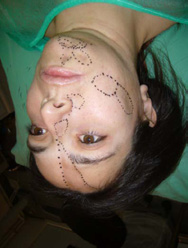
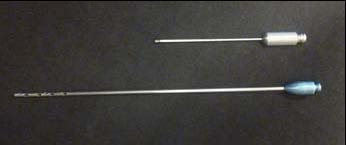
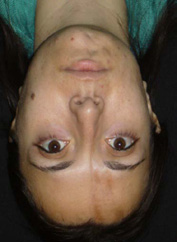
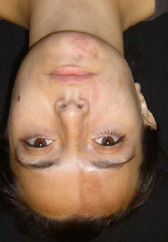
Liapakis et al. (2016)
Bringing Excellence in Open Access
with discoloration of the hair or alopecia areata, atrophy of the
orbital, palpebral, zygomatic and masseter muscles. The final
result is craniofacial asymmetry, affecting the self-esteem of the
patient and their social acceptance [11, 12].
Several surgical techniques have been previously reported
for the treatment of this comdition. For mild cases with soft
tissue involvement, fat/dermal grafts or dermal fillers including
calcium hydroxylapatite, can be used to correct volume loss
[13, 14]. For severe cases with asymmetry, it is advised to wait
for stabilization of the condition and then proceed surgically to
correct the asymmetry [14-16], with free flap transplantation,
alloplastic implants, medial canthopexy or septorhinoplasty.
Figure 2 Intraoperative photo from the lipofiling areas.
The aim of this case report is to present a mild case of Parry-
Romberg syndrome using lipofiling and skin bleaching with a
modified "Kligman's formula" cream.
MATERIALS AND METHODS
A 21 years old Caucasian female patient appeared at our
clinic (OpsisClinical Plastic and Reconstructive Surgery) with left
hemifacial atrophy. She was first diagnosed with Parry-Romberg
syndrome when she was 15years old and she has been stable for
at least 2years.
Cannulas used for liposuction (upper) and lipofiling (lower)
at the face.
The patient was treated by lipofiling of a total of 20cc of fat
at the left forehead, nose, nasolabial crease, cheek, and mental
region (Figure 2). The adipose tissue used for the filing was
harvested from the patient's anterior abdominal wall. After local
anesthesia was administered, the subdermal tissue lifted away
from the underlying structures at the abdomen region by gently
grasping the skin. Autologous fat collection was performed with
rapid palindromic movement at the subcutaneous tissue of 10cc
syringe 1mm in diameter with multiple holes, resulting in an
atraumatic and bloodless collection of fat [17, 18]. Each 10 cc
syringe was gently placed into a sterilized sleeve and centrifuged
at 3000rpm for 2-3min to collect the fat, which was separated
into three layers: the top-layer, composed mainly of oil with
triglycerides derived from the destroyed adipocytes; the middle-
Figure 4 Patient with Parry Romberg pre- and 6 months
layer, composed of purified fat suitable for transplantation; and
the bottom-layer, composed of serum and blood debris. The top
layer of oil was removed and the bottom layer was drained. The
skin and muscle may be involved, however, in more severe
refined fat cells were administered to the underlying tissues
cases, ocular and/or neurologic manifestation may be present
using a blunt tip cannula in 1.7mms in diameter (Figure 3). The
[19]. In younger patients, bony atrophy may require immediate
deposition of the fat was linear in small parts per passage in
intervention [20-22], but recent studies strongly suggest that
order to maximize cell survival.
treatment should be initiated only after disease stabilization
Subsequently, skin hyperpigmentation was treated for one
[13-16]. If treatment begins too early, additional surgeries may
month with a cream containing 5% ascorbic acid in the original
be required [3] to accommodate disease progression, such as
lipofiling, medial canthopexy or septorhinoplasty. The type of
surgical reconstruction almost always depends on the severity
of the deformity. In mild to moderate hypoplasia, lipofiling may
The hemifacial atrophy and the skin hyperpigmentation were
be adequate, but in more severe cases, dermal fat grafts, silicone
significantly improved with no recurrence 6 months after the
implants or adipofacial free flaps may be required in conjunction
treatment (Figure 4).
with skeletal support.
Currently, the use of fat transfer via liposuction was proposed
as the "gold standard" for the correction of Parry-Romberg
Parry-Romberg syndrome is a progressive degenerative
syndrome [24, 25]. The method was first described by Illouz et
disease causing facial deformation, which may impact patient's
al. [26] and was popularized with the introduction of tumescent
self esteem and social appearance. In mild cases, only the fat,
topical anesthesia by Klein et al [27]. However, Coleman at al.
J Surg Transplant Sci 4(3): 1028 (2016)
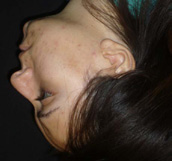
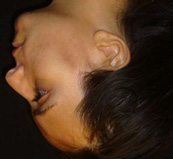
Liapakis et al. (2016)
Bringing Excellence in Open Access
[28] made the most critical modification, improving the overall
glycolic acid can promptly depigment the skin [38]. Kojic acid 2%
success of the technique. He reported the use of a fat aspiration
combined with hydroquinone 2% was shown to be superior to
and re-application protocol, with careful aspiration and
glycolic acid 10% and hydroquinone 2% [39]. The combination
centrifugation, which increased the survive rate of the cells and
of hydroquinone 5%, tretinoin 0.1%, and dexamethasone 0.1%
engraftment [29, 30]. This method is particularly more efficacious
in a hydrophilic ointment was first introduced by Dr Albert
[31] for treatment of the malar, cheek and chin region, but not as
Kligman as the "Kligman's formula" in 1975 [40] and has been
successful for treatment of the upper/lower lip and the temporal
extensively used since for post-inflammatory hyperpigmentation
region. However, Matsumoto [32] and Yoshimura [3], described
(PIH), chloasma, melasma, age spots, scars and nevi of Ota or Huri
improved outcomes of cell survival, angiogenesis, and adipose
[41]. Hydroquinone inhibits the conversion of dopa to melanin by
tissue regeneration by enrichment of the aspirated fat cells with
blocking the activity of tyrosinase [42]. As suggested by Jimbow
adipose-derived stem cells (ASCs). In our study, liposuction was
et al, hydroquinone interferes with DNA and RNA synthesis,
carefully performed at the anterior abdominal wall and cells were
degrades melanosomes and destroys melanocytes [42, 43]. In rare
purified with centrifugation. Only the middle band containing
cases it can cause allergic reaction and contact dermatitis, [44-
purified fat was selected for transfer, while the top and bottom
46] nail bleaching, and ochrosis-like pigmentation [47, 48]. Even
bands were discarded. Application of these cells to the hemifacial
though hydroquinone has been shown to cause animal toxicity
atrophy was achieved at sequential administration of 20ccs of fat.
[49], no complications have been reported in humans [50].
The lipofiling was very careful, after aspiration with successive
Alternative bleaching agents, such as kojic acid or azelaic acid,
movements of the canula since there is evidence of severe
are useful but not as potent as hydroquinone [51,52]. Tretinoin
complications even blindness after filler/fat application at the
0.05%-0.1% reduces pigmentation by inhibiting tyrosinase
nose/forehead areas [34]. We followed the patient 6 months
transcription and by interrupting melanin synthesis [53], but,
after the procedure, since there is no evidence that more time is
in some cases, may cause erythema or increase pigmentation
needed to evaluate the survival of the fat [35, 36].
due to the irritation of the skin [54]. The tretinoin eliminates
A secondary effect of Parry Romberg syndrome is skin
pigment and increases keratinocyte proliferation by preventing
hyperpigmentation. The etiology is not fully understood, however,
oxidation of hydroquinone, therefore it improves epidermal
combination treatments can improve the skin's pigment [37]. For
penetration. Furthermore, adding topical corticosteroids reduces
example, azelaic acid combined with 0.05% tretinoin or 15-20%
the irritation of the other agents and inhibits melanin synthesis
by decreasing cellular metabolism [55]. The addition of ascorbic
acid to the original "Kligman's formula" can increase the activity
and efficacy of the hypopigmenting agents by improving the
anti-oxidant effect and collagen stimulation (Figure 5, 6). In this
study, skin hyperpigmentation was treated using 5% ascorbic
acid into the "Kligman's formula". The treatment performed for
1 month every night (to eliminate the erythema) and applied
gradually to the skin: the 1st week applied 1hour before sleep,
the 2nd week 2hours before sleep, the 3rd week 3hours before
sleep and the 4th week all the night long. The day after and every
Figure 5 Patient before and 1 month after treatment with cream
day after the treatment, a hydration/sun care cream (with SPF
(modified "Kligman's formula" and 5% ascorbic acid).
over 30) applied to the skin in order to eliminate the irritation/
dehydration of the skin.
CONCLUSION
Parry-Romberg syndrome is a degenerative disease that
leads to soft tissue atrophy as well as the skin hyperpigmentation.
Surgical intervention is often required using fat transfer in
conjunction with skin bleaching. We report a case of a patient
treated with lipofiling and a modified cream which resulted to
significant improvement and stable results for at least 6 months.
Our results suggest that adding 5% ascorbic acid at the original
"Kligman's formula" may improve the skin bleaching, however,
more studies are required to establish the power of the results.
REFERENCES
1.
Figure 6 Patient before and 1 month after treatment with cream
(modified "Kligman's formula" and 5% ascorbic acid).
J Surg Transplant Sci 4(3): 1028 (2016)
Liapakis et al. (2016)
Bringing Excellence in Open Access
11. Stone J. Parry-Romberg syndrome. Pract Neurol. 2006; 6:185-188.
14. Cox SE, Soderberg JM. Idiopathic hemifacial atrophy treated with
serial injections of calcium hydroxylapatite. Dermatol Surg. 2010; 36:
19. Gorlin R, Cohen N, Hennekam R. Syndromes with unusual facies: Well-
Known Syndromes. Syndromes of the Head and Neck. 4th ed. New
York, NY: Oxford University Press, 2001:977-1038.
J Surg Transplant Sci 4(3): 1028 (2016)
Liapakis et al. (2016)
Bringing Excellence in Open Access
46. Ennes SB, Paschoalick RC, Mota De Avelar Alchorne M. A double-
blind, comparative, placebo-controlled study of the efficacy and
tolerability of 4% hydroquinone as a depigmenting agent in melasma.
J Dermatolog Treat. 2000; 11:173-179.
Cite this article
Liapakis IE, Christopoulos A, Tzouganakis AC, Paschalis EI (2016) Lipofiling and Modified "Kligman's formula" for the Treatment of Parry-Romberg Syndrome. J Surg Transplant Sci 4(3): 1028.
J Surg Transplant Sci 4(3): 1028 (2016)
Source: http://www.myplasticsurgery.gr/media/1478/lipofiling_and_modified-klingman_formula.pdf
Wp-brodd-r3.qxd
ATP Working Paper Series Working Paper 05–01 Factors Affecting U.S. Production Decisions: Why are There No Volume Lithium-Ion Battery Manufacturers in the United States? Economic Assessment Office Advanced Technology Program National Institute of Standards and Technology Gaithersburg, MD 20899-4710
The dubai logistics cluster
THE DUBAI LOGISTICS CLUSTER Alanood Bin Kalli, Camila Fernandez Nova, Hanieh Mohammadi, Yasmin Sanie-Hay, Yaarub Al Yaarubi COUNTRY OVERVIEW The United Arab Emirates (UAE) is a federation of seven emirates, each governed by its own monarch. The seven Emirates - Abu Dhabi, Ajman, Dubai, Fujairah, and- jointly form the Federal Supreme Council, which chooses a president